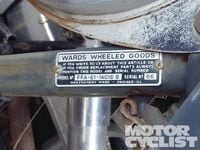Gather around, children, and hear of a time before smartphones, iPads, Facebook or even the Internet. Believe it or not, before the advent of eBay and Amazon, people could shop in the privacy of their homes. Instead of web browsers and mouse clicks, however, they used things roughly the size of Honda Gold Wing saddlebags: Sears Roebuck & Co. and Montgomery Ward catalogs.
Yes, these giant paper catalogs were a mainstay in America. Mother could order the latest time-saving home appliance while father browsed workshop and garden tools. Sis could find her favorite dolls and dresses, and Junior could get his first glimpse at the semi-revealed female figure in the hallowed feminine undergarment section.
More importantly, when he was ready, Junior (or Sis) could order up a real-life motorcycle. From the 1950s through the ’70s, Sears and Ward’s offered a range of motorcycles to the increasingly mobile American consumer—many remarkably exotic in their design and origin, but re-labeled for the particular department store.
On a recent sojourn to an “open-air motorcycle museum” (i.e. a junkyard), I made it my mission to find examples of these re-branded bikes. The owner of the yard was a treasure-trove of information on the breed. Although the history of the catalog motorcycle dates back much further (Sears, in fact, offered bikes in the teens), we chose to focus on examples from the post-WWII era.
The bikes were usually offered in a variety of small displacements: 125, 175, 250 and 360cc.They were shipped to the consumer in the crate just as they were packed in Italy, Austria or elsewhere. It was up to the customer to assemble it.
Some of the companies that supplied the American catalog retailers were the most successful racing marques of the time. Gilera dominated Grand Prix racing in the post-WWII era. Benelli’s race successes dates back to the 1920s, and include an Isle of Man TT win in 1950. Even Puch had its share of racing successes dating back to the ’30s.
Montgomery Ward’s stint in the mail-order motorcycle game lasted about a decade, from the late ’50s through the late ’60s. Ward’s pulled most of its scooter line from Japan, but the actual motorcycles came from Benelli and carried the Ward’s “Riverside” badge.
The mail-order motorcycle market was not wildly successful for Ward’s, and was phased out in ’69. The Sears catalog motorcycle venture lasted a little longer, the retailer offering bikes up until the late ’70s.
Sears’ “Allstate” brand was actually composed of re-badged Puch two-strokes from Austria. By all accounts, some of the Allstates were fast little screamers. One of the cool variations was the split-single or "twingle"—a twin that fired both cylinders at the same time.
Although most of Sears’ offerings were manufactured in Austria, the company also offered Italian Gileras for a time. The Sears Gileras’ styling, in fact, made them an attractive starting point for café-racer conversions continuing to this day.
Department-store motorcycles were a diverse and interesting lot. They were much like those exotic figures Junior spied in the undergarment section: titillating and alluring, but with enough fabric to keep the mystery alive. Mail-order rides had an allure all their own, and those Sears or Ward’s decals hid enough of the story to make additional pursuit of the truth necessary. MC













/cloudfront-us-east-1.images.arcpublishing.com/octane/HXOUJXQWA5HBHGRO3EMJIGFMVI.jpg)

/cloudfront-us-east-1.images.arcpublishing.com/octane/3TIWWRV4JBBOLDVGRYECVVTA7Y.jpg)
/cloudfront-us-east-1.images.arcpublishing.com/octane/KIX5O23D5NAIBGFXBN3327DKZU.jpg)
/cloudfront-us-east-1.images.arcpublishing.com/octane/7GJYDUIPXRGMTMQKN6ONYOLBOU.jpg)
/cloudfront-us-east-1.images.arcpublishing.com/octane/MUQLOVLL2ZDGFH25ILABNBXKTI.jpg)
/cloudfront-us-east-1.images.arcpublishing.com/octane/TNOU5DNE2BC57MFPMGN2EIDXAM.jpg)
/cloudfront-us-east-1.images.arcpublishing.com/octane/GTCXACQGJ5HAPDTGWUQKDEH44E.jpg)
/cloudfront-us-east-1.images.arcpublishing.com/octane/S35YGSEMEZB4BLTDJTSZPF4GLA.jpg)
/cloudfront-us-east-1.images.arcpublishing.com/octane/5UOT6HPX2JFMRJAX6EH45AR4MQ.jpg)
/cloudfront-us-east-1.images.arcpublishing.com/octane/OKWOJWAKP5EP3OACCRRWPCIX2Q.jpg)
/cloudfront-us-east-1.images.arcpublishing.com/octane/2WF3SCE3NFBQXLDNJM7KMXA45E.jpg)
/cloudfront-us-east-1.images.arcpublishing.com/octane/G4MG6OUCJNBSHIS2MVVOTPX65E.jpg)
/cloudfront-us-east-1.images.arcpublishing.com/octane/IIGGWFOTOJGB7DB6DGBXCCMTDY.jpg)
/cloudfront-us-east-1.images.arcpublishing.com/octane/QSTCM6AVEZA5JJBUXNIQ3DSOF4.jpg)
/cloudfront-us-east-1.images.arcpublishing.com/octane/U4I7G625B5DMLF2DVIJDFZVV6M.jpg)
/cloudfront-us-east-1.images.arcpublishing.com/octane/B6XD6LS6IVCQPIU6HXDJSM3FHY.jpg)
/cloudfront-us-east-1.images.arcpublishing.com/octane/ICL63FEDDRDTTMINYICCEYGMDA.jpg)
/cloudfront-us-east-1.images.arcpublishing.com/octane/FCGZHQXRBZFLBAPC5SDIQLVF4I.jpg)
/cloudfront-us-east-1.images.arcpublishing.com/octane/WNOB6LDOIFFHJKPSVIWDYUGOPM.jpg)

/cloudfront-us-east-1.images.arcpublishing.com/octane/X33NU3E525ECRHXLNUJN2FTRKI.jpg)
/cloudfront-us-east-1.images.arcpublishing.com/octane/6KKT5NNL2JAVBOXMZYS5ZO76YA.jpg)
/cloudfront-us-east-1.images.arcpublishing.com/octane/J5RKG5O455GMPGQRF2OG6LRT7A.jpg)